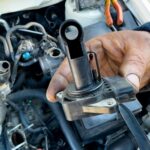Freeze frame data in OBD2 is a crucial tool for diagnosing car problems. It provides a snapshot of your vehicle’s sensor readings at the exact moment a fault code was triggered. Understanding this data can significantly aid in pinpointing the root cause of malfunctions. This comprehensive guide will delve into what freeze frame data is, how to interpret it, and answer frequently asked questions.
Understanding OBD2 Freeze Frame Data
Freeze frame, in essence, captures the state of your car’s various sensors when a diagnostic trouble code (DTC) is set. Think of it as a photograph of your engine’s performance at the critical moment a problem occurred. This snapshot includes vital information such as:
- Engine RPM: The speed at which the engine was rotating.
- Vehicle Speed: How fast the car was traveling.
- Coolant Temperature: The temperature of the engine coolant.
- Calculated Load: The engine’s load percentage.
- Fuel System Status: Indicates whether the engine was running in open or closed loop.
- Short and Long Term Fuel Trim: Adjustments made to fuel delivery to maintain optimal air-fuel ratio.
This data, coupled with the associated DTC, offers valuable clues for mechanics and car enthusiasts alike. For example, a freeze frame showing high engine RPM and low vehicle speed during a misfire could point towards a transmission issue.
Example of Freeze Frame Data Displayed in OBD Software
Why is Freeze Frame Data Important?
Freeze frame data is essential for several reasons:
- Identifying Intermittent Problems: Issues that occur sporadically can be difficult to diagnose. Freeze frame data provides evidence of the problem, even if it’s not currently present.
- Pinpointing the Root Cause: By analyzing the sensor readings, mechanics can narrow down the potential causes of a malfunction, saving time and diagnostic effort.
- Verifying Repairs: After a repair, comparing the freeze frame data before and after can confirm the effectiveness of the solution.
How to Access and Interpret Freeze Frame Data
Most OBD2 scanners can retrieve freeze frame data. The data is usually displayed alongside the corresponding DTC. While some scanners provide raw data, many translate it into a more user-friendly format.
Interpreting freeze frame data requires some knowledge of automotive systems and sensor readings. Comparing the captured values to the manufacturer’s specifications can help identify anomalies. Consulting repair manuals or online resources specific to your vehicle’s make and model can provide further guidance.
Common Questions about Freeze Frame Data
Can there be multiple freeze frames?
Yes, some vehicles store multiple freeze frames for different DTCs or instances of the same DTC.
What if there’s no freeze frame data?
While rare, it’s possible for a DTC to be set without accompanying freeze frame data. This can happen due to specific vehicle configurations or if the data was overwritten.
Can there be a freeze frame without a check engine light?
In some cases, a check engine light might be temporarily triggered and then cleared, but the freeze frame data may remain stored, indicating a potential intermittent problem.
Can I clear freeze frame data?
Yes, clearing DTCs with an OBD2 scanner typically also clears the associated freeze frame data. However, if the underlying problem persists, the DTC and freeze frame will likely reappear.
Conclusion
Understanding “What Is Freeze Frame In Obd2” is crucial for effective car diagnostics. This snapshot of your vehicle’s sensor readings at the moment of a fault offers invaluable clues to identify and resolve car problems efficiently. By leveraging this data, car owners and mechanics can save time and effort in pinpointing the root cause of malfunctions, leading to quicker and more accurate repairs.
